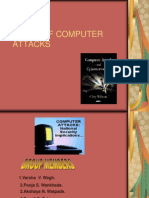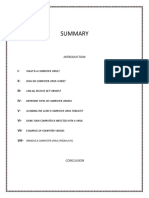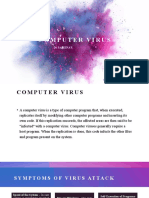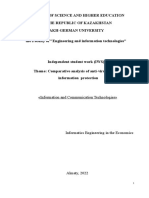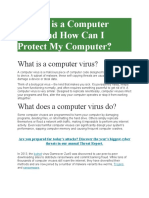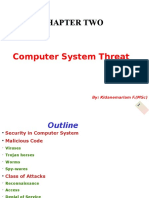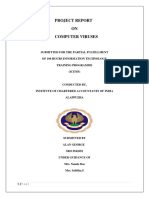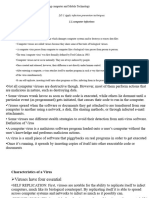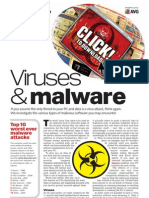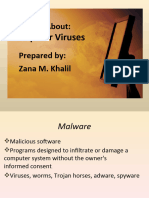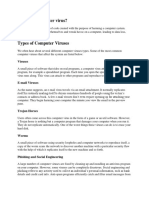0 ratings0% found this document useful (0 votes)
31 views17 pagesUnit 5 Computer Applications
The document discusses various computer security threats, focusing on types of viruses, malware, and prevention measures. It categorizes threats into physical and non-physical, detailing specific types of malware such as viruses, worms, and Trojans, along with their methods of spread and potential damage. Additionally, it emphasizes the importance of security measures like antivirus software, data backups, and cautious online behavior to protect against these threats.
Uploaded by
ratnakarr981Copyright
© © All Rights Reserved
We take content rights seriously. If you suspect this is your content, claim it here.
Available Formats
Download as PDF or read online on Scribd
0 ratings0% found this document useful (0 votes)
31 views17 pagesUnit 5 Computer Applications
The document discusses various computer security threats, focusing on types of viruses, malware, and prevention measures. It categorizes threats into physical and non-physical, detailing specific types of malware such as viruses, worms, and Trojans, along with their methods of spread and potential damage. Additionally, it emphasizes the importance of security measures like antivirus software, data backups, and cautious online behavior to protect against these threats.
Uploaded by
ratnakarr981Copyright
© © All Rights Reserved
We take content rights seriously. If you suspect this is your content, claim it here.
Available Formats
Download as PDF or read online on Scribd
You are on page 1/ 17
Internet and Virus: El
Security, hardware and Software Threats. Computer Viruses: Types of Viruses, Logic Bombs, Torzan
Horses, Worms. Virus Prevention, Things that are not Virus, Antivirus,
lementary Internet Application, Security Control: Physical Security, data
In Depth Information
Computer Security Threats
Computer security threats are potential threats to your computer's effici
operation and performance. These could be harmless adware or dangerous tr fa
infection. As the world becomes more digital, computer security ‘concen ae
always developing. A threat in a computer’ system is a potential danger that could
jeopardize your data security. At times, the damage is irreversible.
Types of Threats:
A security threat is a threat that has the potential to harm computer systems and
organizations. The cause could. be physical, such as a computer containing
sensitive information being stolen. It’s also possible that the cause isn’t physical,
such as a viral attack.
1. Physical Threats: A physical danger to computer systems is a potential cause of
an occurrence/event that could result in data loss or physical damage. It can be
classified as:
« Internal: Short circuit, fire, non-stable supply of power, hardware failure due
to excess humidity, etc. cause it.
« External: Disasters such as floods, earthquakes, landscapes, etc. cause it.
¢ Human: Destroying of infrastructure and/or hardware, thefts, disruption, and
unintentional/intentional errors are among the threats. He
2. Non-physical threats: A non-physical threat is a potential source of an incident
that could result in: :
« Hampering of the business operations that depend on computer systems.
«Sensitive — data or information loss
» Keeping track of other’s computer system activities illegally.
+ Hacking id & passwords of the users, etc.
‘The non-physical threads can be commonly caused by:
(i) Malware: Malware (“malicious software”) is a type of complet program that
( ctteates and damages systems without the users’ knowledge. Malware trite to g0
aan iced by either hiding or not letting the user know about its presence Of” Te
i i i lower rate than usual.
system. You may notice that your system is processing at a sI u
a Visus: It is a program that replicates itself and infects your computer's files
and programs, rendering them inoperable. It is a type of malware that spreads by
Prepared By Kajal Pandey
becoming part of another Progra software
¢mbec re \
documents Ter 0 another using the networ" \
insert f so one comy
Ip of red from
with the help OF ST fe
"
a
as an executable file.
cL They usually appear le He
docimens and et ered eal, THEY USBI ram that tacks, Tecords, ang
disk, file sI ai ‘
ute* Piithout their permission for the
2 Spyware ofl line) without nission for 4
cin Serr at 4 onside acquired from a variety o| sources,
rete of vail er may also unwittingly in
i eis nt hats a a A ei User License Agreement.
poding websites, ine eae proj eee ee eS
by aoe is primarily utilize
2 rare that is pri
are i Y ing patterns in to compile data on the
ire ithe so at web browsing patterns in order
~ online, it keeps
Ds pe : t they replicate
jae oe Gompulr Worms are similar to viruses in that they repli
Y + Cot
(iv) Worms: Cor
H i ich spread by
‘ict’ simi Unlike viruses, whicl F
inflict similar damage. eres alte aches
fae ei file, worms are freestanding programs that do ron a mans
een ey human assistance to proliferate, Worms don _ change programs;
eae they replicate themselves over and over. They just eat
instead,
stem down. : oe ie
he ‘ojan: A Trojan horse is malicious software that is disguised as a useful
yewan is nun, the Trojan performs a harmful/unwanted
program. When the host program is run, e Trojan perfo aa
action. A Trojan horse, often known as a Trojan, is malicious malware or software
that appears to be legal yet has the ability to take control of your computer. A
‘Trojan is a computer program that is designed to disrupt, steal, or otherwise harm
your data or network.
(Wi Denial Of Service Attacks: A Denial of Service attack is one in which an
attacker tries to prohibit legitimat
te users from obtaining information or services,
An attacker tries to make a system or network Tesource unavailable to its intended
users in this attack. The web
commerce, tradin;
servers of large organizations such as banking,
(vii) Phishing: Phishing,
ito
or
g organizations, etc. are the-victims
.Phis is a type of attack that is i
They de cn Om Wes Such as login eedeni went Set obtain
They deceive users into giving critical information, Pind cae
information, or access to personal
email messages, and instant chats,
Key-Logge
» such as b; i
accounts, by wo ank and credit card
ts: Keyloggers can
(\ rs Monitor a us
time. Keylogger is a Program that i
keystroke made by ioe
a user, then sends th
passwords and financial © data to a
u +. records every
Tae eae hacker with the intent of stealing
How to make your system secure:
In order to keep your s
stem d; ‘
measures: vetem Geta secure and safe, you should take the following
1. Always keep a backup of your data,
2's computer activity in res].
background and ity in real.
Prepared By Kajal Pandey
\
so boots :
are Dake, uhdny 2, sto = EGE, ia ee bodies
2. Install firewall software arid keep it updated every time. E c
3. Make. use of strong and difficult to crack passw i i
ords (hi i
alphabets, numbers, and special characters). Pasowords (eta ge & mall
4. Install antivirus/ anti-spyware and keep it updated every time.
5. Timely scan your complete system.
6. Before installing any program, check whether it is safe to install it (using
Antivirus Software).
7. Take extra caution when reading emails that contain attachments.
8. Always keep your system updated.
Computer Virus Definition
oftware application or authored code that can attach
jiself to other programs, self-replicate, and spread itself onto other devices. When
executed, a virus modifies other computer programs by inserting its code into them. If
the virus’s replication is successful, the affected device is considered “infected” with a
computer virus.
A computer virus is an. ill-natured s«
out by the virus’s code can damage the local file system,
download additional malware, or any other actions the
|. Many viruses pretend to be legitimate
their devices, delivering the computer
The malicious activity carried
steal data, interrupt services,
malware author coded into the program
programs to trick users into executing them on.
virus payload. :
Types of Computer Viruses
Every computer virus has a payload that performs an action. The threat actor can code
any malicious activity into the virus payload, including simple, innocuous pranks that
don’t do any harm. While a few viruses have harmless payloads, most of them Coed
damage to the system and its data. There are nine main virus types, some of whicl
could be packaged with other malware to increase the chance of infection and damage.
The nine major categories for viruses on computers are: oe
Boot Sector Virus :
the operating
inting to
ve has a sector solely responsible for pointing 1 ereontols the
Your computer dri r
boot into the interface. A boot sector virus
system so that it can
rn cm E, RAIPUR.
[ee bisa COLLEGE, RAIPUR €
<<
RS
DISHA I coors
aur et gre __ Ee
* ing the macht Usually,
puter virus, The virus is activated whey,
wre, rend
a the drive, renee) © ma
foot: sector of ON 19 spread this CO
1 5 USB devices D achine.
nai USD device and boot their mac
plu
Web Scripting Virus cea
defenses against malicious web scripts, Paap cr, ‘UNSUPPorteg
Most browse Tr biles allowing atackers f0 code on the local device.
browsers have ;
Browser Hijacker
on your browser will hijack. browser
.e the settings h
ones ‘and your search preferences and redirect you to a
site or an adware page used to steal data or
‘A computer virus that
Id be a phishing
favorites, the home page
malicious site. The site coul
make money for the attacker.
Resident Virus .
‘A virus that can access computer memory and sit dormant until a payload is delivered
is considered a resident virus. This malware may stay dormant until a specific date or
time or when a user performs an action.
Direct Action Virus
When a user executes a seemingly harmless file attached ici
hen a < i to malicious code, direct-
anton viruses deliver a payload immediately. These computer viruses can also mal
lormant until a specific action is taken or a timeframe Passes. ae
Polymorphic Virus
Malware authors can use . Z ie
i polymorphic cod $e
de we le to chang °,
“tection. Therefore, it's more difficult for an antivi S me a 's footprint to avoid
mus to detect and remove them.
File Infector Virus
Multipartite Virus
Prepared By Kajal Pandey
_DISHA GOLLEGE, RAIPUR
‘E-eratt: principal tishacotagetihtstersl ee
Disha Pak udng Fit or, arn Nese tata Mart | tyr war ca
‘Behind NIT and Hotel Procadiy, Ratpur (C16) 492010 Conant 190.1 OTTEAIAPAON, 9EIOO-OATS
These malicious programs spread across a network of other systems by copying
themselves'or injecting code into critical computer resources.
Macro Virus
s ditional malware
Microsoft Office files ean run macros that can be used fo download ad
aennip malicious code, Macro viruses deliver a payload when the file is opened and the
What Causes Computer Viruses?
Computer viruses are standard programs; instead of offering useful resources, these
programs can damage your device. Computer viruses are typically crafted by hackers
peer various intentions, like stealing sensitive data to causing chaos in systems. Some
Markers create these malicious programs for fun or as a challenge, while others have
more sinister motives like financial gain or cyber warfare.
Hackers may exploit weak points in an operating system or app to acquire unapproved
access and power over a user’s machine to achieve their goals.
. Ego-driven: Some virus authors seek fame within the hacker community by
creating destructive or widespread viruses that garner media attention.
= Cybererime: Hackers often use computer viruses as tools for ransomware
aitacks, identity theft, and other forms of online fraud.
= Sabotage: In some cases, disgruntled employees create computer viruses to
intentionally damage their employer’s infrastructure.
+ Cyber espionage: State-sponsored hackers may develop advanced persistent
threats (APTs) using custom-made malware designed for long-term infiltration
into targeted networks.
For a threat actor to execute a virus on your machine, you must initiate execution.
Sometimes; an attacker can execute malicious code through your browser or remotely
from : another network computer. Modern browsers have defenses against local
machine code execution, but third-party software installed on the browser could have
vulnerabilities that allow viruses to run locally.
The delivery of a computer virus can happen in several ways. One common method is
via a phishing email. Another technique is hosting malware on a server that promises
Prepared By Kajal Pandey
a 8
felivered using macros or by inj \
. ae
malicious code into legitimate s \
Work?
How Do Computer Viruses
t hitch a ride on other files or
i discreet programs that 2 7
oe bet primary pjective js to replicate and spread like
to provide a legitimate
At their core, computer
applications. In most cases,
wildfire. i
i i ther
: ici ftware ograms designed to nfect o
function i aan In Diy so, a virus will attach itself to an
Computer viruses
‘to spread.
programs by modifying them in
unsuspecting file or application in order
The Infection Process
‘A virus can attach itself to any legitimate program
execute its code, such as an email attachment or a
springs into action an
the file is opened or downloaded, the virus
Hiding in Plain Sight
Computer viruses can be quite crafty to remain hidden from both users and antivirus
software alike. Viruses employ stealth techniques such as polymorphism, which
changes their appearance, or encryption methods.
The Damage Done
Once activated, a virus may wreak havoc on your computer system. It can steal
sensitive data, corrupt files, slow down performance, and even crash your entire
system. It can spread from system to system after a user takes action that either
intentionally or accidentally facilitates it.
It’s important to note that viruses are j ot types
‘im just one type of malware, and many other
malicious software can harm your computer or steal your personal information. f
How Do Viruses Spread?
Computer viruses spread through various channi i these clianne
Compute els, and bei t
is essential to protect yourself and your organization from infection. oe : sf
Email Attachments
Prepared By Kajal Pandey
or document that supports macros to
file download from a website. Once
d starts executing.
[DISHA COLLEGE, RAIPUR:
peal ces alt ences
sete enaice ee
‘One method of virus transmission is through em:
their malicious code as seemingly harmless files, s
unsuspecting users open without a second thought. For
‘Trojan campaigns are known to spread via email attachments
financial statements.
Internet Downloads a
si
aware installers, media £65 OF Crt browser exten:
it to be cautious whens ee wnload
from unknown sources OF sketchy websites. A notorion® oe ee
scandal, where popular applications were ‘bundled with 3
programs by default.
File Sharing Networks
‘and peer-to-peer platfo:
f P tf
File sharing networks like torrent sites aa
i ie torrents OT cracked software Ay
Ke installation. For
viruses. Innocent-lool Q
vmise your device upon
‘ner, so when somet
payloads designed to compro
Fate Bay used a browser-based cryptocurrency miner, S° ™ e
ee nek computer was used to mine ‘ceryptocurrency without their knowledge or
consent.
Removable Media
Viruses can attach to removable media, such as US
any computer they're plugged into. ‘The infamous
a we that spreads through removable media.
To protect yourself and your organization from computer viruses, always exercise
caution and employ robust cybersecurity measures like up-to-date antivirus software
Gnd regular system scans. Remember, knowledge is power, especially when preventing
viruses and cyber-attacks.
What Is a Computer Worm?
‘A computer worm is a type of malware desi icate i spread
m1 E signed to replicate itself to to
computers Unlike computer viruses, worms do not require a host program to fas
and self-replicate. Instead, they often use a computer network to spread themsel
relying on security failures on the target computer to access it. ne
Viruses can also hide in so!
that you download from the web. t's
ms can easily transmit
hidden,
SB drives and CDs/DVDs, infecting
Stuxnet worm is a prime example of
Prepared By Kajal Pandey
‘as a host to scan and infect oi
omputers are compromised, the Wom
ing these computers as hosts. W;
‘dth loads, resulting in overloadeg
at device
i Wd
t C omputer Virus Do?
a. 1ow it’s coded. It could be something as
age, or it, could be sophisticated: lead}
only affect a local device, but oth —
vulnerable hosts.
The
simple & # Pevity and vironment :
ce continues delivering a payload until its
host devi ad 1
ater virus tha fers offer small removal programs that, eliminate: the
‘a computes antivirus, Vo removal difficult because they change their footprint
re lymorph ad Jealing dala, destroying dats, or interupting
sonsistently. TRE Pex or the local device.
n
Viruses VS- Malware
meaning, malware and viruses are two distinct
to net
Spread 20705 ®
yn and
Computer
in intentio sapeably.
ile overlapping :
ae tet are often used interch
<< a general term for any tyPe of malicious software, while a virus is a specific
Malware ‘avare that self-replicates by inserting its code into other programs. While
type oF eg type of malware, not all malware is @ ViFuS.
ware can take many forms, including viruses, worms, trojans, spyware, adware,
and ransomware, and it can be distributed through infected websites, flash drives,
emails, and other means. A virus requires a host program to run and attaches itself to
legitimate files and programs. Jt causes a host of malicious effects, such as deleting or
encrypting files, modifying applications, or disabling system functions.
Signs of Computer Virus
a
Maivare authors write code that is undetectable until the payload is delivered.
fete that youec no a bi issues while the virus runs.
Signs that you have a compalteees i virus Pec gould present = oe
= de
- Pe is a d
opup windows, including ads (adware) or links to malicious websites.
Mal
Prepared By Kajal Pandey
Ly jing 1, First Floor, Ram Nagarkote
pa tott Po tel Peay Repu (2)apmom ™ | wna
dentin in
en cetacean
Pen Sonnet nen
ger home page chan; ot 0771-40400 S039 oe
1
y Ve Z 4 our contact li
} mails t0 Y' act list or people o
nd 2 0 n your contact fi
st messages sent by your account. tact list alert you to
stom
hes often, runs out of
uter ras s memot
he com e blue screen of death in Windows,
+ gispl® Ss
ry with few active Programs or
yuter performance even when running few
slow Sly booted. Programs or the computer
was 3
unknow? programs start when the computer boots or when you open specific
programs.
passwords change without your knowledge or your interaction on the account.
. Frequent error messages arise with basic functions like opening or using
programs:
of Computer Virus
Example
‘ons of computer viruses, but only a few have gained popularity
tains milli
Ts of machines. Some examples of widespread computer
The web co}
rd numbel
and infect reco)
viruses include:
‘Worm —One of the earliest and most pervasive computer virus
this self-replicating computer program spread through the early
ing down or crashing many machines.
« Morris
examples, th
Internet in 1988, slowi
. Nimda — This particular type of worm targeted web servers and computers
running Microsoft Windows operating systems, spreading through multiple
infection vectors in 2001.
ILOVEYOU — A highly destructive worm that spread via email, disguised as
alove confession and caused widespread damage in 2000 by overwriting files.
computer worm that exploited ¢
work congestion and
SQL Slammer —A_ fast-:
yer, causing net
vulnerability in Microsoft SQL Se
disrupting Internet services in 2003.
Prepared By Kajal Pandey
SS a
designed to target and sabotage, j 2
ed worn’s nuclear’ program, by exploitin, tUstial
ty Iran’s Ploiting zerg, de
y
somware Trojan, which infected hundreds
* cont i
van gg This F90S0%O13, encrypted victims’ files and demandea”*
10 MS co Po ein a
+ fpousinds gneir deo? ; :
inso™ gine jn 2008, this savebee vulnerabilities;
ner ting a massive botnet and causing «+
- s, creating ausing wides,
fickel — ing system: ‘Pread
Confick™ pera
° , ws
winde i:
infection” in < is banki ji imari
: irst discovered an oe cal oe agen Primarily {ireeted -
cTinba.— stitutions, aiming and . banking
* gnancial
fe emation-
orm that aimed to remove the Blaster worm from infected
welchia — patel the exploited vulnerability but caused unintended network
tems and
angestion in 2003.
_A macOS-specific Trojan that primarily spreads through fake
. Slayer and downloads, delivering adware and potentially unwanted
0! updates iy te
programs since 2018.
How to Remove a Computer Virus
Removing a computer virus can be a challenging task, but there are several steps you
can take to get rid of it. Common steps to remove a computer virus include:
. Download and install antivirus software: Assuming you don’t already have
antivirus software installed, download and install a real-time and on-demand
solution, if possible. A real-time malware scanner scans for viruses in the
background while you use the computer. You must start the on-demand
scanner whenever you want to scan your device.
=
; & :
2. Disconnect from the internet: Some computer viruses use the internet
connection to spread, so it’s best to disconnect from the internet when
so) S
removing a virus from your PC to prevent further damage.
Prepared By Kajal Pandey i
a
fro Park, Butléing 2, Fire R i hic
i esa et OR
any temporary files: Depanqee ee
porary files can also delete the vine on the type of virus, deleti
tergate when YOUF computer boot np, " 8S Some viruses are designs
Reboot your computer into
+ Computer while you remove
will inhibit the virus fro;
effectively.
safe 2 iti
a ee To help mitigate damages to your
sa ini Teboot your device in ‘Safe Mode.’ This
ing and allow you to remove it more
5. Runa Virus scan: Run a full scan usi ivi *
most thorough or complete sony eine Your antivirus software, opting for the
anni i . ,
pour hard drive leters during ans option available. If possible, cover ll
6. Delete or quarantine the virus: Once the vind id aa
eare! 2 7
software will give you the opt s is detected, your antivirus
2 re u tion to delete or quarantine the virus.
Quarantining the virus will isolate it from the rest of your computer to prevent
it from causing further damage.
7. Reboot your computer: Assuming you’ ve effectively removed the virus, your
computer can be rebooted. Simply turn on the device as you would do so
normally without initiating the “Safe Mode” option.
8. Update your browser and operating system: To complete the virus removal
process, update your operating system and web browser to the latest version
possible. Browser and OS Updates -often contain fixes for particular
vulnerabilities and exploits.
Given the general nature of this process, the outcome may vary from virus to virus and
device to device. If you are unsure if you’ve effectively removed a virus from your
computer, contact an IT or computer professional for assistance.
How to Prevent Computer Viruses
Computer viruses can damage your PC, send sensitive data to aitacker and cause
downtime until the system is repaired. You can avoid becoming the puter
virus victim by following a few best practices:
i nected to
+ Install antivirus software: Antivirus should run on any device 2 comes
the network. It’s your first defense against viruses. Antivirus
it ‘ice.
malware executables from running on your local devi
Prepared By Kajal Pandey
=. LC
so 90012015 - ‘
DISHA COLLEGE, RAIPUR:
earring i eon | Wega arian seme |
‘attachments: Many malware: “attacks
Executable
+ Don’t. open executable :
malicious email_attachment. F
‘hould avoid running macros
including ransomware start with a
attachments should never be opened, and users sI
programmed into files such as Microsoft Word or Excel.
Keep your operating system updated: Developers for all major operating,
systems release patches to remediate common bugs. and security
Vulnerabilities. Always keep your operating system updated and stop using
end-of-life versions (e.g., Windows 7 or Windows XP).
email
estionable websites: Older browsers are vulnerabl¢ to exploits used
ite. You should always keep your browser updated
avoid these sites to prevent drive-by downloads or
fey
+ Avoid qu
when just browsing a webs'
with the latest patches and
redirecting you to sites that host malware.
Don’t use pirated software: Free pirated software might be temy
often packaged -with malware. Download vendor softwaré ‘onl:
official source and avoid using software pirated and shared software:
Use strong passwords: Make sure your passwords are highly secure and
difficult to guess. Avoid using the same password across multiple accounts and
gate vulnerabilities and prevent hackers from
change them regularly to miti
stealing them.
ilant: Always be cautious when downloading files or software
us email attachments. Tum off file
computer with someone you don’t
Pte fyhath
pting, but it’s
ly: from the
« Remain vi
from the internet or opening suspiciot
sharing and never share access to your
know. Also, avoid keeping sensitive or private information stored on’ your
computer
DISHA COLLEGE, RAIPUR
‘bisha park, Buttding 3 First Hoor Ata Nagar Kote More, pent eederai
(Behind NIT afd Hotel Piccadilly, RaRpUr (CS) 492010 Contact fest "0773-4349400, 96300-04424
“Unit 5
Physical Security, data
et and Virus: Elem Internet Application, Security Control:
Secuniyhd i ware 7 ‘Logic Bombs, Torzan_
Security, hardware and Software Threats. Computer Viruses: Types of Viruses,
Horses, Worms. Virus Prevention, Things that are not Virus, Antivirus:
1. Elementary Internet Applications
“The internet is a global network that connects millions of private, public, academic, business,
Work tibles a variety of services and applications, some of which
and government networks. f
and s0veE for businesses and daily activities. Here are some, key elementary internet
applications:
«Web Browsing: Web browsers (like Google Chrome, Firefox, Safari) allow users to
aesees and navigate websites. Web browsing is the most common internet activity.
= Email: Email is one of the earliest and most widely used internet applications.
Eaattes like Gmail, Yahoo, and Outlook provide a platform for sending, receiving,
and managing messages. ;
«Search Engines: Google, Bing, and Yahoo are examples of search engines. These
allow users to find information on the internet by entering keywords or queries.
«Cloud Storage: Services like Google Drive, Dropbox, and OneDrive enable users to
store and share files online.
= Online Shopping: E-commerce websites like Amazon, Flipkart, and eBay allow users
to buy and sell products.
«Social Media: Platforms like Facebook, Instagram, Twitter, and LinkedIn are used for
personal networking, business marketing, and information sharing.
= Instant Messaging: Applications like WhatsApp, Telegram, and Slack provide real-
time communication. se
2. Security Control
He
Security. controls are measures put in place to protect an organization's data, systems, and
information from threats or unauthorized access. Below are the primary types of security
controls:
A. Physical Security
Physical security involves protecting physical assets from damage or theft. This includes:
+ Aceess Control: Restricting unauthorized physical access uters, serve
sensitive data. ° Pa Siaee ea een
+ Security Guards: Employing guards to monitor access i
to premises.
«Alarm Systems and CCTV: Setting up surveillan
eieten Syston aa g up surveillance cameras and alarms to detect any
+ Locking Systems: Using locks on doors, cabinets, areas _containin,
valuable data or equipment. eS noe —
Prepared By Kajal Pandey
el
B. Data Security unauthori7
A ‘ :
ing data fro! inp Rs
Data security refers to protecting 4 at Loy Sues F only auithorized ers! ca
Measures include: owpel OY format transactions noo
jon fo incom ing
+ Encryption: Data is converted ee ‘and controls :
dlcerypt. For example, usin — qhat mone jg not lost due to corruption or
‘irew Software or ha rized 2 cure it is -
network traf, blocking unaurfing 49 ensive dividuals can access sensitive
* Backups: Regularly backing indi
ized in . :
attacks. ang that only autho metric systems:
+ User Authentication: Ensuring Oo vopds, OF
data, usually through.usernames,
i s. Examples
‘C. Hardware and Software Threats 2 result in data los: ip
F are Can ized access to Critical
4 ¢ to hardwé unauthori
* Hardware Threats: Physical Careb) ysical devices, OF
include hard drive failure, the
infrastructure.
+ Software Threats: Software thre
hacking, phishing, and denial of servi
data, compromise systems, and disrupt
., worms, ransomware),
ues are
ats include malware (virus corrupt or steal sensitive
These can
attacks. 5
business operations.
3. Computer Viruses
gram desi licate itself and spread from one
A computer virus is a malicious program designed to rep! re ee
computer to another. It can corrupt files, steal data, and damage systems. Here YP
of computer viruses:
A. Types of Viruses
1. File Infector Viruses: These viruses attach themselves to executable files (exe, com,
etc.). When the file is opened, the virus gets activated and may cause harm. i
¢ Example: CIH virus, also known as Chemobyl, which could corrupt files and
even overwrite system data. ie
2. Macro Viruses: These viruses target software appli
© Example: Stone Virus.
4. Polymorphic Viruses: These viruses
ic viruses,
system, making them difficult to detect by
Prepared By Kajal Pandey
Le
» DISHA COLLEGE, RAIPUR
‘Disha Park, Butlding 2, First Floor, Ram Nagar-kota |
' | Sool
sian anche haeareeanate™ | Sao
©- Example: ZMist virus.
B. Logic Bombs
A logic bomb is a type of malicious software that is triggered by a specific event or condition,
such as a date, a particular user action, or other criteria. They are usually hidden inside a
larger program or file.
Example: A logic bomb might delete critical files on a system on a specific date, such
as deleting all data on December 31st.
C. Trojaz Horses
‘A Trojan Horse is a type of malware that appears to be a legitimate program but contains
malicious code. Unlike viruses, Trojans do not replicate themselves but are often used to
provide unauthorized access to a system.
Example: The Zeus Trojan, which is used for stealing financial data.
D. Worms
Worms are self-replicating programs that spread across networks without the need for human
intervention. Unlike viruses, they don’t need to attach themselves to programs or files.
‘Worms can cause widespread damage by consuming network resources.
« Example: The WannaCry ransomware attack, which spread across the intemet in
2017, affecting computers worldwide.
4, Virus Prevention
Preventing virus attacks is critical to maintaining the security and functionality of computer
systems. Here are common prevention methods:
«Antivirus Software: Antivirus programs (like Norton, McAfee, Bitdefender) detect
and remove viruses from the system. They should be updated regularly to recognize
new threats. :
+ Regular Software Updates: Keeping operating systems and software applications up
to date ensures that vulnerabilities are patched, making it harder for viruses to exploit
them. 3
+ Email Caution: Avoid opening attachments or clicking on links from unknown or
suspicious emails, as they may contain malware. ;
ss to the system, preventing
Firewalls: A firewall helps block unauthorized acce
worms and other malicious programs from spreading.
Prepared By Kajal Pandey
Gates you visit use HTTPS and thar yey
Secure Websites: A! int distri ‘e regulal
i 1a r ted or stolen.
avoid suspiciou: it that you yout ‘data is corrup
* Backup Regularly: Ensunit rus i
sed by
mitigate the damage cal!
S. Things that are Not Viruses
Ips,
es and other types of software that may be
rus
al vil
It’s important to distinguish between actus
misunderstood as viruses: ¢ downloads advertising material
‘cally displays © free software.
tically displays OF “up ads from
+ Adware: Software that automatica¥) "7 ample: P ir knowledge. It’s not a
when a user is online, but itis not ut users without a
~* Spyware: Software that colle “i redirecting you
virus but can compromise eee the settings of your browser, AES Ve
odie uebetce, While annoying and disrapive they are
ferent .
6. Antivirus Software
, including viruses,
Antivirus software is designed to detect, prevent, and remove seer ie
‘worms, and Trojan horses. Some popular antivirus programs 4
+ Norton Antivirus: Offers real-time protectio1
email scanning, and anti-spyware
features. Gees 2 ab shemale
+ McAfee: Provides virus protection along with web safety tools and identity thef
protection.
+ Bitdefender: Known for its ad
ransomware protection. 8
+ Kaspersky: Offers real-time Protectio
features, including anti-phishing anc
} =
eee g
and deep system scans for detecting threats.
or
ks for known vii jignatures (code
+ . Heuristic-based Detection: It looks { oe Patterns).
presence of a virus or malware.
+ Sandboxing: New programs are tested i
4
: in an isolated envi
safe before being executed on = sn ‘solated environment to ensure they ar
Conclusion 3
You might also like
- Comparative Analysis of Antivirus SoftwareNo ratings yetComparative Analysis of Antivirus Software19 pages
- 16 08 2024 22 - 58 2024 08 16 11 - 06 - 01No ratings yet16 08 2024 22 - 58 2024 08 16 11 - 06 - 0116 pages
- Malware: Group 8 Christine Domingo Ludjango Bigueras Ivan Zyann Magdaraog Jash Lourence Baloyot Princesa AringoNo ratings yetMalware: Group 8 Christine Domingo Ludjango Bigueras Ivan Zyann Magdaraog Jash Lourence Baloyot Princesa Aringo40 pages
- Viruses & Malware: Staying Safe Online Know Your MalwareNo ratings yetViruses & Malware: Staying Safe Online Know Your Malware10 pages
- Siminar About: Prepared By: Zana M. Khalil: Computer VirusesNo ratings yetSiminar About: Prepared By: Zana M. Khalil: Computer Viruses20 pages
- 9 - G10 CSS ICT Module For 3Q W1 2 VirusAntivirus Virtualization SoftwareNo ratings yet9 - G10 CSS ICT Module For 3Q W1 2 VirusAntivirus Virtualization Software9 pages


